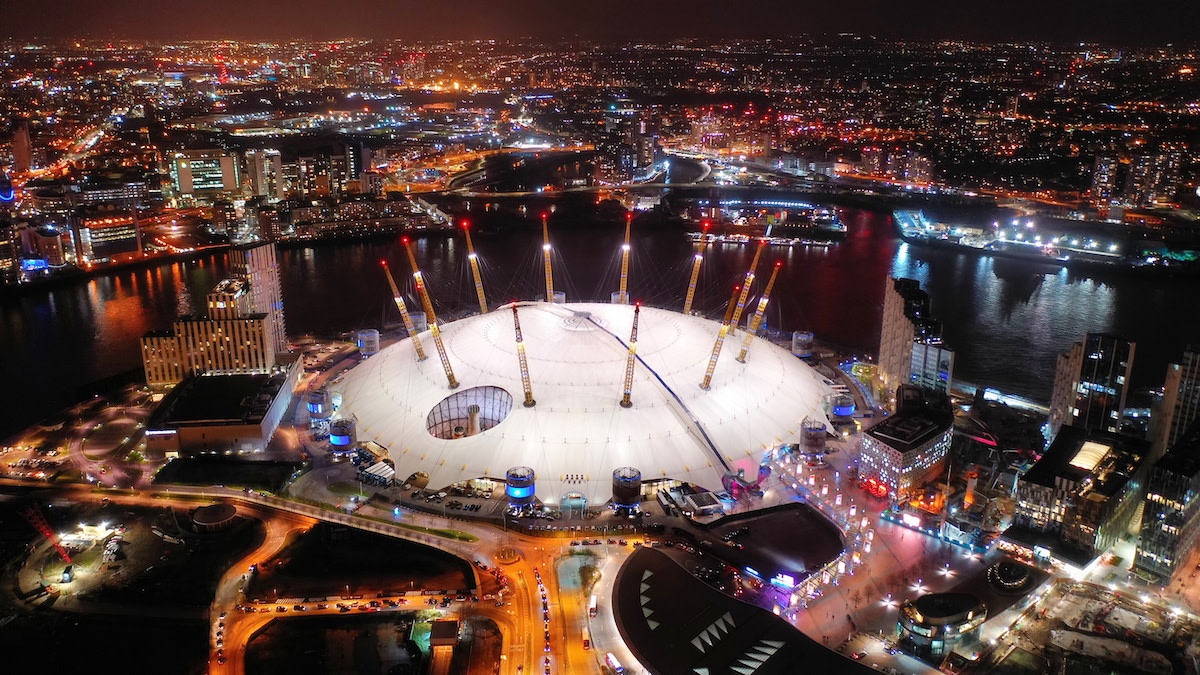Millennium Dome Facts: History and Architectural Highlights
Written by MasterClass
Last updated: Sep 23, 2022 • 3 min read
Located on the Greenwich Peninsula in England, the Millennium Dome (also known as the O2) is one of the largest dome structures in the world. The building has had a fraught history, beset by financial woes, political struggles, and other setbacks. Its storied history, as well as its staggering size, make it one of the most recognizable landmarks in the United Kingdom.
Learn From the Best
What Is the Millennium Dome?
The Millennium Dome is a dome-shaped structure near the Canary Wharf in South East London. To access it by public transit, you can get off the North Greenwich stop of the London Underground’s Jubilee Line.
The Dome takes its name from the dawn of the common era’s third millennium—an occasion for which the building served as a celebratory monument. Since it first opened on New Year’s Eve 1999, the Millenium Dome has become The O2 Arena.
A Brief History of the Millennium Dome
Learn how the Millennium Dome progressed from the initial concept to the O2 entertainment complex and arena it is today:
- Origins: Prime Minister John Major’s Conservative government first conceived of building the Millennium Dome as a centerpiece for a rebooted Festival of Britain (an event that first took place in 1951). Major delegated oversight responsibilities to his Deputy Prime Minister Michael Heseltine. Heseltine in turn selected Jennie Page to serve as the initiative’s CEO and joined forces with the architectural firm Richard Rogers Partnership and contractors McAlpine/Laing Joint Venture to begin development.
- The Millennium Experience: At the time of its initial construction, the Millennium Dome was to serve as the site of a major exhibition: the Millennium Experience. A project the Millennium Commission spearheaded, this exhibit featured fourteen zones celebrating different aspects of the human experience as well as British identity. In the late 1990s, Labour politician Tony Blair became the UK’s new Prime Minister. He aimed for the Dome to be even more extravagant than his predecessor intended.
- Political issues: Financial problems and political scandals began to bog down the project, as well as other logistical issues. Blair and his Deputy Prime Minister John Prescott dismissed Peter Mandelson, their first pick to oversee the project, and replaced him with Lord Falconer of Thoroton in 1998. The exhibition ultimately opened on New Year’s Eve 1999, thanks in part to help from new leadership at the New Millennium Experience Company.
- Redevelopment as The O2 Arena: The Millennium Dome remained open for all of 2000 and then closed. In 2005, architectural and engineering firms HOK + SVE and Buro Happold announced they would redesign the Dome as the O2 entertainment complex. Inside the broader complex, the O2 Arena stands as one of Britain’s premier music venues. It also housed gymnastics events during London’s 2012 Summer Olympics, for which it underwent a rebrand as the North Greenwich Arena for sponsorship reasons.
The Millennium Dome: 4 Architectural Highlights
As a feat of architectural design, the Millennium Dome (or the O2) possesses many impressive features, such as:
- 1. A circular structure: The Dome has an almost perfectly symmetrical circular structure. Midway through the structure, the Blackwall Tunnel (an underwater route British motorists take beneath the River Thames) lets off exhaust. Needless to say, visitors cannot spend time in this portion of the building.
- 2. A light roof: Panels of PTFE (or Teflon or “glass fibre fabric” in British English) serve as the basis for the dome’s arching canopy. A ring of steel masts holds up the roof, which is literally lighter than air—it has less mass and density than the amount of oxygen the building itself contains.
- 3. Record-breaking size: The Millennium Dome is the largest dome structure in the entire world. The building, which is not a self-supporting structure, boasts a 1,050-foot diameter and rooftop steel masts that rise almost 330 feet. The world’s largest self-supporting dome structure is Singapore National Stadium, which is nearly 1,024 feet in diameter and 272 feet tall.
- 4. Support towers: Structural engineers worked hard to assure the Millennium Dome would stand tall. Twelve tensile support towers—to symbolize each month of the year and hour of the day—hold up the rooftop.
Learn More
Get the MasterClass Annual Membership for exclusive access to video lessons taught by the world’s best, including Frank Gehry, Will Wright, Annie Leibovitz, Kelly Wearstler, Ron Finley, and more.
